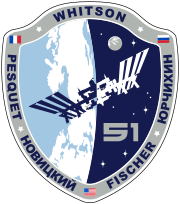ISS expedition 51
| Mission emblem | |||
|---|---|---|---|

|
|||
| Mission dates | |||
| Mission: | ISS expedition 51 | ||
| Crew: | 5 | ||
| Rescue ships: | Soyuz MS-03 , Soyuz MS-04 | ||
| Space station: | International space station | ||
| Start: | April 10, 2017, 07:58 UTC | ||
| Started by: | Decoupling from Soyuz MS-02 | ||
| The End: | June 2, 2017, 10:47 UTC | ||
| Ended by: | Decoupling from Soyuz MS-03 | ||
| Duration: | 53d 2h 49m | ||
| Number of EVAs : | 2 | ||
| Total length of the EVAs: | 6h 59min | ||
| Team photo | |||
 v. l. To the right: Jack Fischer, Fyodor Jurtschichin, Thomas Pesquet, Peggy Whitson and Oleg Nowizki
|
|||
| navigation | |||
|
|||
ISS Expedition 51 is the mission name for the 51st long-term crew of the International Space Station (ISS). The mission began with the disengagement of the Soyuz MS-02 spacecraft from the ISS on April 10, 2017 and ended with the disengagement of Soyuz MS-03 on June 2, 2017.
team
Taken over from ISS Expedition 50 :
- Peggy Whitson (3rd space flight), commander ( USA / NASA , Soyuz MS-03 )
- Oleg Wiktorowitsch Novizki (2nd space flight), flight engineer ( Russia / Roskosmos , Soyuz MS-03)
- Thomas Pesquet (1st spaceflight), flight engineer ( France / ESA , Soyuz MS-03)
Additionally from April 20, 2017:
- Fyodor Nikolajewitsch Yurtschichin (5th space flight), flight engineer (Russia / Roskosmos, Soyuz MS-04 )
- Jack David Fischer (1st space flight), flight engineer (USA / NASA, Soyuz MS-04)
Substitute team
Since Expedition 20, no official replacement team has been announced due to the permanent training for the six-person crew. Unofficially, the backup crews of the two Soyuz feeder spaceships MS-03 and MS-04 (see there) are considered substitute crews for Expedition 51. As a rule, these crews are deployed two missions later.
Mission description
Crew exchange
On April 20, 2017 - ten days after the start of the expedition - the feeder spaceship Soyuz MS-04 docked with the ISS after a six-hour flight; the ISS crew was increased to five people.
The day before Soyuz MS-03 undocked with Oleg Novizki and Thomas Pesquet, Fyodor Yurtschichin took over the ISS command . Together with Jack Fischer and Peggy Whitson, who exceptionally stayed on board for a third expedition, he formed the initial crew of the subsequent ISS Expedition 52 .
Freight traffic
On April 22, 2017, Commander Peggy Whitson and Thomas Pesquet used the Canadarm2 gripper arm and captured the Cygnus OA-7 cargo ship . Then the gripper arm was rotated by commands from the ground station so that Cygnus could be attached to the underside of the Unity module .
External works
On May 12th, Peggy Whitson and Jack Fischer replaced an electronics unit on the spare parts platform EXPRESS Logistics Carrier (ELC) as part of an EVA . The replacement parts were brought to the station by Cygnus OA-7 . They also mounted a protective shield on the Pressurized Mating Adapter -3 (PMA-3), which was moved from the Tranquility module to the Harmony module in March .
On May 20, a multiplexer-demultiplexer (MDM) data relay box on the S0 grid element failed . Exactly this box was only installed on March 30, 2017 by Shane Kimbrough and Peggy Whitson with improved software during an external mission. These double redundant boxes control the functions of radiators , solar panels , cooling circuits and other station hardware. Since a failure of the other box, which is now active alone, would lead to massive restrictions in ISS operations, an unscheduled EVA was set for May 23rd. The spacecraft was carried out by Peggy Whitson and Jack Fischer. While Whitson was replacing the broken box, Fischer installed a pair of antennas for wireless communication on the Destiny laboratory module .
See also
- ISS Proxima
- List of unmanned missions to the International Space Station
- List of space exits
- List of spacemen
Web links
- ISS-Expedition 51 at Spacefacts.de
- ISS-Expedition 51 on the website of NASA (English)
Individual evidence
- ↑ Derek Richardson: Soyuz MS-03 crew returns to Earth after nearly 200 days in space . Spaceflight Insider, June 2, 2017.
- ↑ NASA: Station Managers Give Go for Tuesday Spacewalk. In: NASA Space Station Blog. May 21, 2017, accessed May 22, 2017 .



